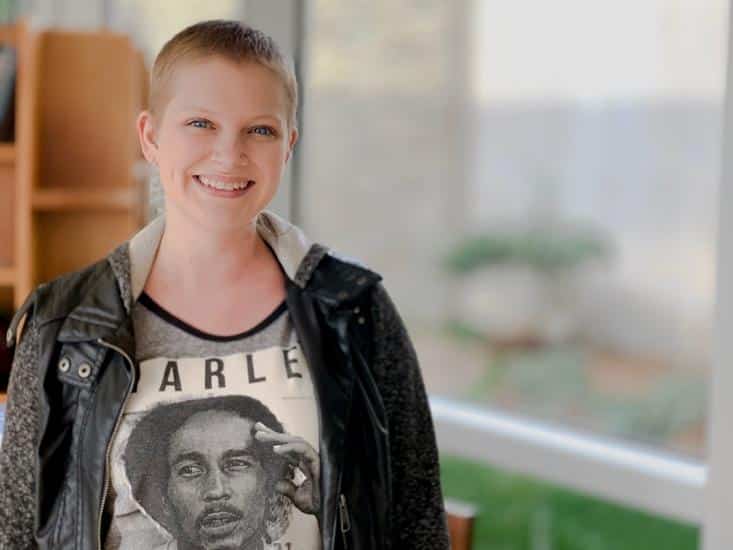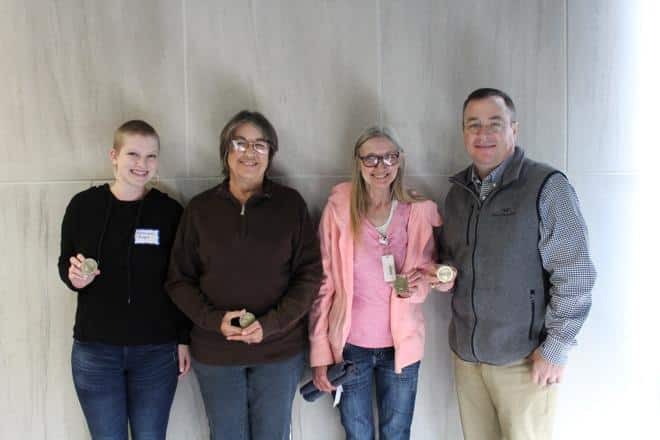

About two and half years ago, at the age of 19, I began to no longer feel like myself. I was exhausted all the time. I couldn’t hike with my friends without feeling weak. I couldn’t sit through a movie without falling asleep, and I seemed to constantly be getting sick.
I was just one year into adult life, but I was feeling much, much older! While I wasn’t expecting to lose the energy of my youth in the span of a year, I tried to put my symptoms aside and power through life. That’s what adults do, right?
However, when the exhaustion was then accompanied by uncontrollable itching, I started second-guessing my self-diagnosis of “adulthood.” I had an annual check-up already scheduled and assumed I’d find some answers then. I was right! My ANA test (an antibody test) came back positive, and I was referred to a Rheumatologist. I had been getting on regardless, so when I was told it would be 10 months before I could be seen, I thought nothing could get worse…right?
When Symptoms Began to Escalate
Six months after my blood test, and still, a few months away from being able to visit a Rheumatologist, I became very sick during a family vacation. Every day, I was running a high fever, I had severe neck pain, and I didn’t have the energy to stay in the sun and enjoy the beach like everyone else. I was living off of ibuprofen and naps. When I started having severe periodic chest pain, I started to panic.
My mom and I immediately went to the urgent care clinic. I was exhausted, dehydrated, and in terrible pain, yet all of the tests they ran came back negative. I scheduled an appointment with my primary care doctor in hopes that any of this would make sense to someone.
Finally Getting an Answer
As I explained my symptoms, my doctor arranged for me to see a different Rheumatologist that very day. Mom and I cried; we thought we were finally going to get somewhere. After a series of tests and visits, I was diagnosed with Lupus. After further tests and more visits, I was eventually diagnosed with Rhupus, Lupus with overlapping features, and rheumatoid arthritis symptoms.
Finally, it seemed I had the answer – Autoimmune disease was to blame for the disappearance of the health I’d known my entire life! I just needed to take the prescriptions the doctor gave me, and I could get back to living.
Unfortunately, my battle for answers was far from over.
Things Get Worse
My inflammation levels continued to climb higher despite various drug regimens. In January of 2019, a year and a half after the medical saga had started, I was prescribed Humira. Over the next few months, things seemed to improve. Having missed out on my last family vacation, I was ecstatic for Spring Break.
However, when it arrived, I felt another “flare-up” coming on. I had the most excruciating chest pain that I had ever felt, and the side of my neck felt tender and swollen. Steroids were my saving grace this time. I began accepting this cycle as my new normal. Life was a series of flare-ups, new meds, moderate relief. Over and over, the cycle continued.
Around July, I noticed that my collarbone would hurt when I put on my seatbelt. One night while feeling around the area, I found a large, swollen lymph node. I looked in the mirror and saw that my neck’s left side was swollen again. I had no other symptoms other than that annoying itching on my legs that never seemed to go away fully. So, I thought maybe the inflammation in my neck was a sign of a flare-up coming.
Not looking for another reason to call the doctor, I decided to give it a few days before I mentioned anything. I was prescribed antibiotics this time, but unlike the typical cycle of feeling better after new meds, the swelling in my neck did not respond to this new treatment, so an ultrasound exam was ordered.
Receiving the Cancer Diagnosis
“Your lymph nodes look angry.” These 5 words from the ultrasound tech were on a loop in my head. Knowing that I should resist the urge but desperate for information, I turned to the most reliable source of knowledge on the planet. If you type the words “angry lymph nodes” into Google, you’ll understand how I arrived at the conclusion that I had lymphoma. We all know better than to diagnose ourselves through the power of Google, but let’s get real – we’ve all done it.
The Google diagnosis was all but confirmed in my mind when I was scheduled for a PET scan the next day. Still, I wanted to believe I was overreacting. A minor headache can turn into a brain tumor if you search Google long enough, right? Maybe the PET scan would confirm the reason we shouldn’t turn to Google: undue stress and anxiety! However, the next day I got the call while I was at work, and my world all but turned upside down.
I went with my parents to the doctor that afternoon to go over the results. My mom, having recently survived lung cancer, was able to get an appointment the next day with her oncologist. On Friday, August 16th, 2019, I met with this oncologist, and he agreed that what he was seeing looked like lymphoma.
Honestly, at this point, I didn’t even need the biopsy results to confirm what was in front of me. I was beginning to realize that I needed to get my mind wrapped around months or even years of treatment and side effects. I had fought so long for the answer. Now was the time to fight for my life.
The Fight Against Cancer
Everything moved quickly from that point. I tried not to think about the cancer that had been growing inside of me undetected for over 2 years. Getting a treatment plan, having surgery, starting chemotherapy, losing my hair – it’s all almost a blur. While some parts of my treatment plan I couldn’t control, I still had very important decisions to make about my care. Of course, I wanted the cancer gone, but after everything I’d been through, I needed to know I was making choices that would maximize my quality of life during and after treatment.
Through hours of research, I discovered that there is almost an overwhelming number of treatment options out there. Go to three different doctors, and you might get three different recommendations. I had already experienced this, having been misdiagnosed multiple times over the previous years. So, I knew I had to be my own best advocate moving forward. I had to be a patient who was willing to speak up and ask questions.
Radiation was part of my treatment plan. Does that sound scary to anyone else? Amazingly, it can be used to treat cancer, but even so, radiation causes cancer — we know that —, and radiation can cause all kinds of other side effects as well.
Given that my tumors were in my neck and chest, I knew I was especially susceptible to side effects caused by radiation. I was terrified of potential damage to my heart, lungs, swallowing muscles, and esophagus. I worried about the risk of secondary malignancies in my breasts. I wasn’t done battling my first round of cancer, and I couldn’t process having to go through it again.
Learning About Proton Therapy
Determined to make the right choices, I expressed these fears to my radiation oncologist. I sat in awe as he explained that the best way to reduce radiation to my organs and healthy tissue was with a form of radiation treatment called proton therapy. Unlike the traditional radiation that I feared, this form of radiation could be stopped inside of the tumor. Since there is no exit dose with proton therapy, the healthy tissue behind the tumors would be spared.
My mind raced with questions. How had I not heard of this? Why wasn’t everyone talking about this incredible technology? Where would I have to go to receive this advanced form of treatment? The radiation oncologist referred me to Oklahoma Proton Center, one of just a few proton centers in the southwest. The treatment that patients across the country have to travel to receive was 5 miles from my home! I finally felt there was a light at the end of the tunnel.
My Experience at Oklahoma Proton Center
My radiation oncologist at Oklahoma Proton Center, Dr. Mark Storey, actually created two treatment plans – one using proton therapy and one using state-of-the-art x-ray therapy treatment called IMRT. He showed me how protons would reduce the radiation hitting my heart and healthy breast tissue compared to IMRT treatment. This, he said, would reduce the potential for me to have heart complications down the road and reduce the risk of cancer in my healthy breast tissue caused by excess radiation.
I recently finished my treatments at Oklahoma Proton Center and had the opportunity to ring the bell and declare that I am a survivor, and a FIGHTER, just like my mom, who also beat cancer, and just like everyone else who has beaten this terrible disease.
In Conclusion: Be Your Own Patient Advocate

After years spent searching for answers and months spent battling this disease, I am ready for a season of peace and rest and normalcy. I am ready to put cancer behind me.
I wanted to share this story because I know others out there like me have chronic medical issues and are searching for answers and relief. My issue ended up being cancer, but I know it could have been anything.
My message is – don’t give up. Keep looking. Keep talking to doctors. Be your own best advocate. And when treatments are recommended, do your own research and be confident in the decisions you make. For me, that meant choosing proton therapy, but it may mean something different for different people.
Once you have cancer, that experience never goes away. It’s something I will live with for the rest of my life. And it may come back at some point. But, I’m thankful that I never gave up and that I had friends and family who supported me along the way. I’m thankful that I finally got answers, and I know those answers are out there for people struggling like I was.
If you’d like to learn about the potential benefits of proton therapy in your fight against cancer, contact Oklahoma Proton Center today.
